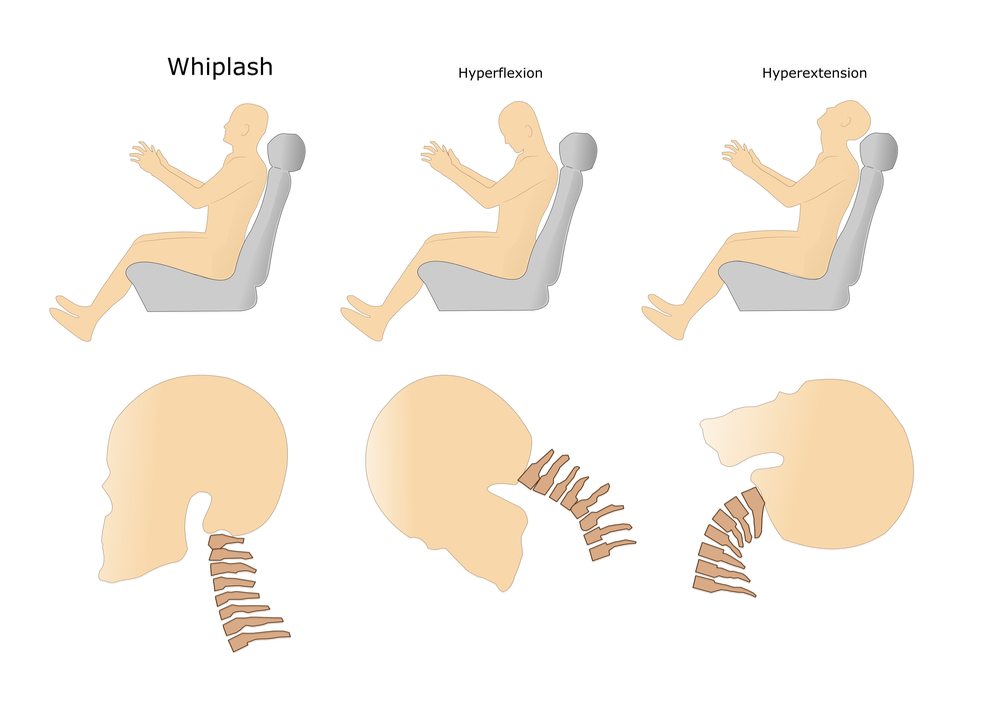
Whiplash occurs when the head is suddenly thrown forward, sideways or backward. It can cause destabilization of the spine and surrounding soft tissue structures. This may cause severe pain as a result of the sudden, jolting movement. Some symptoms of whiplash and other neck injuries include:
- Neck pain
- Blurred vision
- Dizziness
- Headaches
- Reduced motion in the neck
- Neck stiffness
- Referred pain to upper back, shoulder and/or arms
Sometimes pain from whiplash does not occur immediately following the accident but can emerge in the days, weeks or even months that follow. Seeing a doctor of physical therapy that specializes in treating these types of injuries immediately after an accident can help avoid lasting disability.
Back pain and injuries to the spine frequently occur after a car accident. The forces resulting from even a minor collision can be enough to cause trauma to the spine, and surrounding soft tissue structures. If left untreated they can cause lasting disability. Words used to describe your diagnosis might include “bulging disc”, “compression fracture”, “lumbar strain” and many more. These are all treatable with a conservative physical therapy approach and typically do not require surgery. In fact, research has shown in a 1 year follow up, that patients who pursue conservative treatment, have as good or better outcomes when compared to those undergoing surgical intervention.
The soft tissue structures surrounding the neck, back, and even in the arms  and legs depending on what position you were in when the accident occurred, can be injured after a motor vehicle accident. These soft tissue structures have a close relationship with the spine and joints to which they attach. A physical therapist specializing in manual therapy is trained on restoring normal function to these ligaments, tendons and muscles while simultaneously restoring normal biomechanics of the spine and other joints impacted so you heal faster. Specialized “hands-on” treatments that physical therapists can incorporate to help your soft tissue injury include myofascial release, soft tissue mobilization, trigger point release, dry needling, and use of kinesiotape.
and legs depending on what position you were in when the accident occurred, can be injured after a motor vehicle accident. These soft tissue structures have a close relationship with the spine and joints to which they attach. A physical therapist specializing in manual therapy is trained on restoring normal function to these ligaments, tendons and muscles while simultaneously restoring normal biomechanics of the spine and other joints impacted so you heal faster. Specialized “hands-on” treatments that physical therapists can incorporate to help your soft tissue injury include myofascial release, soft tissue mobilization, trigger point release, dry needling, and use of kinesiotape.
4. NUMBNESS/TINGLING AND WEAKNESS
Nerve compressions can be extremely problematic if left untreated. It is therefore vital that you seek advice from a trained medical professional as early intervention is key to full return of function. Nerve pain can often result after a car accident due to the location where the nerve roots exit the spine in the neck and low back. Nerve pain can include numbness, tingling, or weakness in the arms, hands, legs or feet. A physical therapist can use manual therapy techniques as well as instruct you in specific neurodynamic exercises to help centralize and eradicate these nerve symptoms referring into the arms and legs. In addition, your physical therapist may find it helpful to refer you for a EMG or MRI to help in pinpointing your nerve injury.
5. DIZZINESS
After a car accident, you may experience feelings of being off balance, light headed, or as if the room is spinning. The ligaments supporting the joints in your neck may be injured and can change the ability of your body to know where you are in space. This can result in dizziness. You can have these symptoms when the information sent to your brain from your eyes, inner ear, and proprioceptors (the term used to describe the signal to your brain from your body informing it where you are in space), is mismatched. A physical therapist can get to the root of this imbalance by restoring spinal mobility and improving soft tissue tension and spasm to decrease your dizziness. Doctors of physical therapy are also trained in specific treatments that address disturbances within your ear which may result in dizziness or vertigo. We will work to improve your balance by instructing you in exercises including habituation and desensitization activities to obtain fast results.


